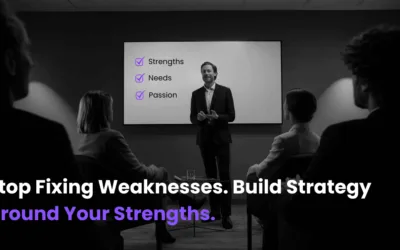When you talk about innovation, you rarely talk about silence. You talk about momentum, visibility, disruption, adoption – about change being seen, felt, acted upon. That’s where thought leadership enters the frame.
At its core, thought leadership is the bridge between what you’re innovating and who you want to influence. It’s not just that someone has a good idea; it’s that the idea is heard, trusted, and embedded into conversation. Here’s why that matters.
Trust as the currency of influence
In an era of “too many voices, too little clarity,” trust is rare and therefore valuable. When a leader puts forward fresh insight, a clear position, a compelling narrative, they are doing more than broadcasting — they are building credibility.
A recent article in Forbes argued that “thought‑leadership is a trust‑building strategy leaders can’t ignore.” Similarly, research about organisational leadership emphasises: “Trust is the lifeblood of effective leadership and high‑performing organisations.” And in the B2B content space, one source notes that high‑quality thought leadership is rated by 89 % of decision‑makers as critical for building trust.
Put simply: if your innovation remains invisible or anonymous, trust (and therefore adoption) falters. Thought leadership is how you signal you know what you’re doing, you’re worth listening to, and there’s value here beyond the hype.
Narrating the innovation‑journey beyond features
Innovation rarely succeeds on features alone — especially in complex environments (government, enterprise, scale‑ups) where stakeholders demand context, alignment and narrative.
Thought leadership enables three shifts:
- From “Here’s what we built” → “Here’s why we built it and what it means”
- From “We have a solution” → “We are part of the transformation”
- From “Buy product” → “Join the movement”
When a leader articulates the story of the innovation — the problem it solves, the journey it represents, the future it opens — they create resonance. They turn a product or platform into a signal of change. In fact, it’s that leadership role – the title, the reputation and standing – that creates the grounding from which influence grows.
Visibility drives pipeline and positioning
In a crowded market, innovation that isn’t positioned becomes undifferentiated. Thought leadership gives you a platform: your voice, your ideas, your interpretation of the market.
When executed well, this drives:
- Network growth (others share, comment, subscribe)
- Top‑of‑mind presence (you appear in relevant discussions)
- Opportunity flow (people call you rather than you chase)
- Organisation alignment (internal teams understand and tell the same story)
And, in turn, greater ROI on innovation investment — not because the idea was better, but because the story was clearer and the influence stronger.
The content economy and market proof
As content becomes a proxy for capability, the market that supports thought leadership (and adjacent services) is expanding. Here’s some sizing and data:
- The global ghostwriting services market (ie professionals creating written content on behalf of individuals/organisations) was valued at ≈ USD 3.3 billion in 2024 and is projected to reach ≈ USD 6.2 billion by 2032, growing at roughly 8.2% CAGR.
- Another report puts the ghostwriting market at ~USD 2.1 billion in 2023, heading towards ~USD 3.5 billion by 2032 at ~6.2% CAGR.
The broader point – as executives and organisations invest in voice, visibility, content, the market for professionalised support is scaling.
What this means: Thought leadership is no longer “nice to have” – it’s an investment channel. When you allocate resources to the story, voice and public profile of your innovation, you’re tapping into a professionalised ecosystem of influence.
Measurement means maturity
No longer can leadership content be a “throw‑it‑on‑LinkedIn” afterthought. Measuring impact matters. Thought leadership analytics (tracking reach, engagement, influence, KPI alignment) is becoming standard.
Why does measurement matter? Because innovation needs justification: board buy‑in, budget allocation, stakeholder alignment. Data helps convert “we did a post” into “we influenced decision‑makers X% faster”, “we increased inbound opportunities by Y”.
Why innovation programs need this narrative layer
Innovation rarely happens in isolation. It’s intricate, multi‑stakeholder, often long‑horizon. Therefore:
- Without leadership narrative, innovation can feel siloed or esoteric.
- Without external visibility, your innovation remains internal — even if it has external value.
- Without internal narrative, adoption lags because people don’t understand the story.
Thought leadership integrates your innovation into the bigger story: your brand’s role, your team’s mission, your market’s future. It’s the narrative glue that anchors innovation to impact.
So what should you do?
If you’re leading an innovation program, launching a new technology, or building a transformation narrative, here are action steps:
- Define the narrative arc: What problem does the innovation address? What future state does it open? Why does your team/organisation uniquely own this story?
- Allocate a content engine: Thought leadership demands regular output – articles, posts, newsletters, maybe videos. Treat it like a campaign, not an experiment.
- Anchor in trust‑building behaviour: Publish original insight, data, stories. Be transparent about challenges + solutions. Consistency will outperform hype.
- Measure what matters: Reach, engagement, inbound interest, stakeholder feedback, media mentions. Use analytics to refine and scale.
- Scale through platforms: Whether it’s leaders speaking on behalf of teams, or team‑wide voices aggregating into brand voice – visibility scales if you orchestrate it.
- Ensure your story surrounds your innovation: Don’t just describe your product – describe the journey, the challenge, the ecosystem, the change ahead.
Leaders drive innovation
Innovation isn’t just about what you do – it’s about who knows you did it, who cares that you did it, and who acts because of it. Thought leadership is the amplifier of that chain. Without it, innovation risks being invisible. With it, innovation becomes influence.
Help your story of change become a story of possibility.
When you’re ready
If you’re ready to start telling your story of innovation at scale – at pace, with clarity and with credibility – our platform can help you build that engine.
Special Offer
Get 50 % off your first month on ProPresence. Use code DCWELCOME at checkout.
Transform your leadership voice, elevate your innovation story, and engage the audience that matters.



